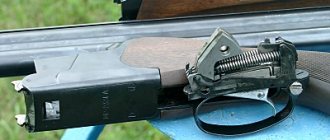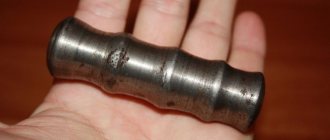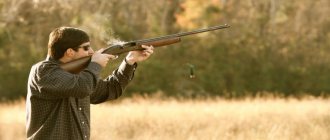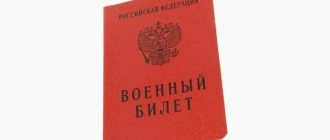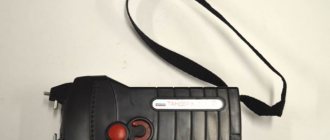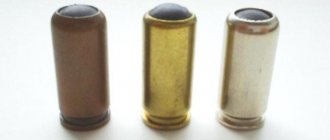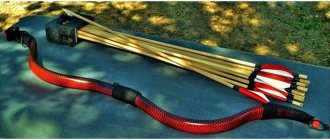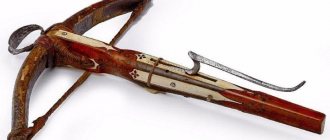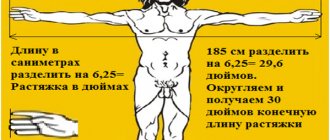Varieties of bows
Bow designs have been constantly improved throughout known history. Currently, such varieties of bows are known.
Traditional bow
This is a bow that was used from ancient times before the invention of firearms. These bows were used by the Indians and many ancient peoples. They were made using technology using natural materials such as wood, leather, and natural adhesives. Mass production of such products will not work, because any onion has its own characteristics.
Classic (sports) bow
This bow is used in sports competitions and because of this it is called “Olympic”. It is similar to the traditional one in the way it accumulates energy to fire a shot. This occurs when the elastic branches of the bow are bent. Most of these bows have a recurve shape - a double bend of the shoulder.
The presence of such a design helps in accumulating twice as much energy with equal length of elastic beams. Thus, one arc is compressed, the second is stretched. Classic is most often a collapsible bow. Recurve bows originated from the Huns, a nomadic steppe people.
The sporting orientation of classic bows predetermined the fact that elements began to be installed on them to significantly increase shooting accuracy. The presence of sights, balancers, shelves for arrows, and vibration dampers serve to eliminate the elements of chance from the training processes to the maximum extent possible.
Another similarity to a traditional bow is the method of holding the arrows while drawing the string.
The most famous of them:
- English - the arrow shank is held using the index and middle fingers;
- Indian - the bowstring is held using the index, middle and ring fingers.
The main element in a classic bow is the shelf on which the arrows are held. An intricate device allows arrows to be released from the bowstring without the feather hitting the handle. Thanks to him, archers abandoned natural feathers and replaced them with solid stabilizers, which significantly increased the accuracy of hits.
Sports rules prohibit placing a device on such a bow, with the help of which a line of sight is built, which can rest on more than one point.
It should be noted that pulling the bowstring is a strength exercise due to the increase in resistance when bending the shoulders. Learning to shoot a classic bow is very complex and this also has similarities with the traditional one.
Compound bow: features
Another third type of bow is the compound bow. Its appearance in 1969 is associated with Holles Allen from the American state of Missouri. Structurally, this is a system of blocks (pulley hoists) that increase the force applied to the running end: as many times as there are blocks.
Compound bow: history and design
The invention of the bow, the oldest long-range throwing weapon, completely overturned previously existing ideas about hunting and war. At first glance, this is a very simple weapon in its design. But over the millennia of its history, the bow has been repeatedly improved, going from an ordinary wooden stick with a bowstring to a rather complex device made of various materials.
Emergence and development
The principle of operation of the bow is very simple. A flexible stick bent in an arc tends to straighten. If you tighten its ends with a bowstring, then when straightened, it imparts enough energy to the arrow to make it fly a distance significantly greater than the throwing range of the dart.
According to their design, bows are divided into:
- simple, consisting of a single piece of wood;
- reinforced, in which a solid wooden base is reinforced in certain places with overlays made of plates of wood, horn or bone;
- complex, in which the bow shaft consists of more than one layer of material, and the wooden base is a single piece along the entire length of the bow;
- composite, in which the bow shaft is assembled from several short parts made of various materials, each of which is characterized by special physical properties.
The technology for making reinforced and composite bows appeared in ancient times in the Middle East, where there was always an acute shortage of quality wood. The nomads from the Great Steppe, for their part, began very early to experiment with the use of various materials in the construction of the bow and achieved significant success in this search.
Image of Amazons shooting from Scythian bows
In the era of classical antiquity, the small Σ-shaped double-curved “Scythian” bow became widespread. Images of the “Scythian bow” are presented on dozens, if not hundreds of monuments of artistic art, from Southern Europe and the Middle East to Central Asia, and on all monuments it looks almost the same. Judging by these images, the length of the “Scythian” bow could range on average from 60 to 110 cm, which made it possible to effectively use it both on foot and on horseback. Small in size, the “Scythian” bow was a very powerful weapon. According to an inscription from Olbia, Anaxagoras, the son of Dimagor, shot such a bow at a distance of 521 m.
Further development of production technologies led to the appearance first of the Kushana-Sassanian bow, and then of the Hunnic type - larger and more powerful, parts of which were made from various types of wood, tendons and horn linings. By alternating rigid (horns and handle) and flexible (shoulders) parts of the bow using overlays on a wooden base, the steppe peoples achieved excellent results in archery.
Design
The study of the remains of bows and finds in the workshops where they were made makes it possible to identify the design, material and recreate some of the preliminary operations for their manufacture.
At the first stage, the base of the bow, or kibit, was made from wood, to which the remaining parts were then attached. The wood for the base did not have to be particularly strong, since the elements made from it experienced minimal stress compared to other parts. Typically, maple and birch were used as materials. The wooden base was first soaked in cold water for about two days, then softened by steam for about two hours, given the required shape using wooden patterns, and finally dried for two weeks.
Parts of the wooden base of a compound bow
At the second stage, the ends of the bow were made. To make them as rigid as possible, they were reinforced on both sides with a pair of bone plates. Then the ends of the bow were attached to the base at an angle, the junction was wrapped with leather thread, and the entire structure was left in a warm and dry room for about a year.
At the next stage of production, parts made from horn were glued to the inside of the wooden base of the bow. When drawn, the bow is subjected to loads that differ in different parts of the bow. The outer side of the bow experienced tensile deformation, the inner side experienced compression. Compared to wood, which undergoes shape deformation at only 1 percent of compression, horn contracts 4 percent before deformation occurs. To achieve this result, a force of approximately 13 kg/mm2 should be applied. In addition, the horn quickly restores its original shape after the force acting on it is removed.
The horns of a buffalo, long-horned bull or mountain goat were best suited for making bows. During the processing process, the horn was first cut to the required length. Then, if it was bent, it was steamed and straightened, keeping it in a special wooden form. The surfaces of the contacting materials were treated with a serrated scraper, after which glue was applied to them, and the parts were firmly connected to each other. The resulting element was bent in the required direction and dried in this form for two or more months.
At the last stage of production, the onion is bent forward with its horns and dried in this form for a year
When the bow limbs were completely dry, tendons were attached to their outer side. This material is characterized by increased strength with a tensile force of about 20 kg/mm2. Bows were made using the back tendons of a cow or deer, which were dried and then kneaded.
The tendons were attached to the wooden base using glue, which was made from dried fish bladders. This glue was more moisture-resistant and elastic compared to casein glue, which was boiled from animal skins and bones. Before gluing, the ends of the bow were tied and it was pulled in the opposite direction. The adhesive composition was applied to the base as many times as possible, then the tendons were glued. All this was dried, and the bow was pulled together even more tightly, then another part of the tendon fibers was attached, and so on until the ends of the arms were connected. Ultimately, the weight of the tendons accounted for up to half of the total mass of the bow. When the process was completed, the master pulled the onion into a ring and left it to dry for another year.
Arrow quiver and saadak of a Turkish bow from the 17th–18th centuries
After the glue had completely dried, the bow was covered with strips of boiled birch bark or thin leather to protect it from moisture, and could also be varnished and painted. The entire process of making a bow took the master from one to three years, and individual parts had to be made at a certain time of the year.
The result of these laborious efforts was an unusually flexible and powerful bow. Without the bowstring, it had a reverse curvature, the tendons were very tense. Such a bow resisted tension from the very first millimeters. When the bow was fully drawn, the limbs curved outwards and acted as levers, bringing the string tension to its maximum. When tensioned, the horn worked in compression, and the tendon worked in tension. Both materials tended to return to their original state and enhanced the power of the bow and the energy imparted to the bowstring. In addition, due to its greater flexibility, the compound bow could be pulled very tightly without the risk of breaking it. This further increased the energy of the bow and the initial speed of the arrow.
Quiver with arrows and saadak made in Russia from the 17th century
When compared with a simple one, a compound bow had significantly greater strength and durability, which allowed it to serve its owner for several decades. The fact is that a simple bow is quite short-lived. In a tense state, the tree quickly lost its elasticity and became deformed, so the bowstring was pulled on the bow only immediately before the battle.
A compound bow could be kept under tension for a long time without the risk of losing its properties. On a hike, this made it possible to wear it almost constantly in combat-ready condition, although, of course, during long-term storage the string was removed from such bows. In battle, a drawn bow was usually carried in a saadak, a flat triangular case. Saadak was hung on the left on the same belt on which the quiver of arrows was worn.
A compound bow in an unstrung form, with a taut string and in the position before the shot
Bowstring
When the bow was pulled, the string experienced a huge tensile load, so the technology of its manufacture was as important as the technology of making the bow itself. As a rule, bow strings were made from linen, cotton or silk yarn, as well as from sheep intestines prepared in a special way. The strongest bowstrings consisted of approximately 60 twisted fibers and were up to 3 mm thick.
Archers always carried one or more items in reserve, including special types of bowstrings designed for certain weather conditions. For example, a bowstring made of horsehair was good in frosty weather, but, unlike a bowstring made of leather or tendon, it easily absorbed moisture and stretched. To attach it to a bow, the string was tied at each end with a complex knot, forming a separate loop of strong and tightly twisted tendon. This method of fastening prevented its wear. The ends of the bowstring were inserted into special notches on the bone horns of the bow.
Various techniques for tying a bowstring and how to attach it to the ends of the bow horns
To pull the string of a powerful compound bow, the archer needed to apply a force equivalent to 50–75 kg. This required great muscle strength and constant training. According to eastern treatises on archery, tension could be carried out in one of three ways. Pulling the bow with a “jerk”, the shooter raised his hands up, then lowered them down, simultaneously spreading them to the sides: pulling the bow, aiming at the target and shooting were carried out in one continuous movement. When “holding,” the bow was smoothly drawn, followed by a pause for aiming and a shot. By “cheating” the bow was pulled halfway, then a pause was made and a “jerk” shot followed.
The Mongols pulled the bowstring with their thumb. In this case, the arrow was placed to the right of the bow, which made it possible to avoid injury to the forearm due to careless or inept handling of the weapon. In addition, such a grip did not lead to overexertion of the hand, which is important when pulling a tight, complex bow. To make it easier to pull the bowstring, a bone or horn ring was put on the thumb. The bowstring was released using a small smooth protrusion, the so-called “ring lip.” As a result, the load on the hand was reduced, and the shot itself occurred smoothly and without jerking.
Different types of bowstring grip: 1 – Persian; 2 – European; 3 – Mongolian
In Western Europe and Rus', the bow string was pulled with the index and ring fingers, and the arrow was held between the index and middle fingers. The arrow was located to the left of the bow, so the left forearm was easily injured in case of careless or inept handling of the weapon.
Arrows
Bow arrows could be made of reed, reed, birch, poplar, walnut, and willow. Heavy arrows were made from poplar for close combat, and light arrows were made from willow for shooting at extreme distances. Reed arrows had the longest range, but were also the most fragile and broke quickly. To straighten the wooden blank for the shaft, it was heated over a fire and leveled by hand. The length of the arrow was equal to the distance from the shoulder to the end of the middle finger, or from the armpit to the end of the middle finger, or from the elbow to the other elbow, if the fists rested against each other. The arrow had a plumage of two or four feathers, connected so that it twisted slightly in flight. Feathers from geese, swans, owls and other large birds were used for plumage. Sometimes plumage could be made from thin sheets of parchment.
Arrows and their tips of various types
Arrowheads come in different sizes and shapes. The socketed points were attached to the shaft by means of a metal sleeve, the stem points were inserted into the tip of the shaft by means of a thin spike and secured in place with glue and tendon fibers. The latter significantly prevailed over the others. The arrows were carried in a cylindrical quiver made of wood, birch bark and leather. The quiver could hold about 20 arrows. Steppe nomads, as a rule, carried arrows with the tip up, so that the archer could select the type of arrow he needed by touch. To prevent the feathers of the arrows from becoming wrinkled in the quiver, its lower part was made wider than the upper.
Application
The compound bow was a formidable weapon, capable of striking enemies at great distances. In terms of firing range, it was one third superior to a simple bow, being capable of sending arrows to a distance of 375 meters and even further. However, the effective firing range of the composite bow was 175 meters, and the sighting range was from 50 to 75 meters. At this distance, the arrow pierced the chain mail. A well-trained archer at this distance can hit the center of a target about a meter in diameter.
Indo-Iranian archer, 17th century
At a greater distance, shooting was carried out “in areas” and for “harassing fire,” forcing the enemy to stay at a considerable distance. As the distance increased and shooting “in areas,” the effectiveness of the shelling decreased. When conducting staged experiments, an experienced archer at a distance of 90–270 meters accurately hit a target 45 meters in front and 18 meters in depth, simulating a detachment. At a distance of 300 meters and beyond, the hit percentage dropped by half.
A study of sources shows that when shooting at concentrations of enemy manpower, horse archers fired from a long distance in a volley, sending arrows with great frequency, almost without aiming. The rain of arrows falling from the sky had a strong psychological effect on the enemy and caused significant losses. By maintaining a high rate of fire for some time, they sought to force the enemy to counterattack in a position unfavorable to him, or to retreat.
Turkish archer in a 17th century miniature
The individual training of archers was very high. Professional archers knew how to shoot while sitting in the saddle, standing on their feet and squatting. They knew how to throw an arrow over the fortress wall and let it fall under raised shields. At a normal pace, the archer should have fired 12 shots per minute, and if necessary, twice as much. It was expected that a well-trained horseman, galloping, should be able to fire five arrows while reducing the distance with the enemy from 30 to 5 meters. To maintain a high rate of fire, he kept the arrows ready in his left hand.
Literature:
- Gorelik M.V. Weapons of the Ancient East (IV millennium BC – IV century BC). M.: Nauka, 1993. – 349 p.
- Litvinsky B. A. Temple of Oxus in Bactria (Southern Tajikistan) in 3 volumes. T. 2: Bactrian weapons in the Ancient Eastern and Greek context. M.: Eastern literature, 2001. – 528 p.
- Medvedev A.F. Hand-held throwing weapons (bow and arrows, crossbow) VIII - XIV centuries. M.: Nauka, 1966. – 180 p.
- Nikonorov V.P., Khudyakov Yu.S. Maodun’s whistling arrows and Attila’s “Mars Sword”: Military affairs of the Asian Xiongnu and European Huns. St. Petersburg, 2004. – 320 p.
- Payne-Gallway R. Book of Crossbows. History of medieval throwing weapons. M., 2007 – 415 p.
- Shokarev Yu. V. History of weapons: Bows and crossbows. – M.: AST, 2006. – 176 p.
What is a compound bow
This is a product that structurally contains blocks with an eccentric axis. To the side closer to the shooter, a bowstring is attached to the blocks, and in the opposite direction the cables are wound. As a result, when the bowstring is tensioned, the blocks begin to unscrew and absorb the cables. At this moment, the bowstring is released and the shoulders come together. As a result, kinetic energy accumulates, which accelerates the released arrow.
A special role is given to the eccentric axis of the blocks. As a result of its action, in contrast to the classic bow used for hunting, at the moment of increasing stretch, the need for the shooter's effort decreases, rather than increases.
The greatest load in the process of firing a shot is found not at the very beginning of opening the bow, but at its end. In other words, a compound bow pushes the arrows out, giving them acceleration. This principle of operation can also be used for a sports bow.
The presence of this property allows shooters to spend more time on quality aiming, since such a hunting bow can be held in the cocked position for a longer time. When shooting from a sports bow, a special “release” device is used - a kind of trigger, thanks to which the shooter will not be injured.
Popular manufacturers
The following brands are most often included in the ratings of the best bow manufacturers:
- Interloper. The largest Russian brand specializing in small arms (bows, crossbows) for athletes and accessories. The products are of very high quality and comply with all regulations and standards. The assortment and price range is very wide. New models created using modern materials and the latest technologies appear regularly.
- Man-Kung. A company from China (Taiwan) produces sporting and hunting bows and crossbows. The weapon is valued for its excellent quality, reliability of block systems, accuracy and high speed of arrow flight, and soft recoil after a shot. The assortment is simply huge, the prices are affordable.
- Core Archery. A relatively young brand from Belgium that produces bows for professional athletes and just shooting enthusiasts. The range is not too wide, but the quality is consistently high. The cost is in the middle price segment.
- Jandao. The company produces a wide range of sports bows for professionals and beginners, as well as amateur ones, and accessories for them. The cost is quite affordable. The undoubted advantages are the reliability and durability of the weapon.
- Touchwood. A Belgian brand specializing in amateur models at affordable prices, as well as exclusive traditional products. The quality in both cases is excellent.
- Samick. A company from South Korea that produces hunting, sporting and traditional bows for both the mass consumer and professional athletes. All models meet the highest quality standards, the cost of amateur bows is budget.
- Bowmaster. A brand from the USA that offers hunting and sporting bows and crossbows that can withstand long-term use in “field” conditions. Its products are valued for their durability and stylish design.
To protect yourself from purchasing a counterfeit (regardless of the chosen brand), it is strongly recommended that you familiarize yourself with the quality certificate confirming the originality of the model.
How to choose a bow for shooting is a problem that almost every beginner faces when starting to master this weapon. There are many varieties of it, they differ in design and other characteristics. To choose the right option, you first need to consider which category this model belongs to. And it is desirable that the first bow be produced by a reputable brand that cares about the quality of its products, guaranteeing its reliability and durability.
Interloper
Man-Kung
Core Archery
Jandao
Touchwood
Samick
Bowmaster
Combat effectiveness of bows
- A classic bow gives all its energy to the arrows when the bowstring is released. With a short-term pulse of force, the arrows fly at speeds of up to 50 m/s and do not have high penetrating force. However, this has the effect of increasing the rate of fire if you do not jerk or pull the bowstring too hard;
- Blockers' arrows accelerate rather slowly. The peak of power occurs at the moment they leave the shelf, and the arrows themselves fly at speeds of up to 90 m/s. You can use heavier arrows with greater penetrating power. As a result of this, these bows are often positioned as hunting bows. At a low rate of fire, it is impossible to partially draw the bowstring. However, in terms of accuracy and accuracy, this bow is not inferior to firearms.
Problems of choice
When choosing a throwing weapon, they usually focus on compliance with historical truth (aesthetics), combat effectiveness, ease of ownership, and price.
Truth and aesthetics
Many people are drawn to archery by the desire to be like the elf Legolas or other fantasy or historical characters. Although archaeologists have proven the fact that English archers suffered from monstrous scoliosis.
- The most reliably repeating the contours and design of traditional bows are products from the Samik company (pr. Deer Master). The handle is made of laminated solid wood, and the removable arms are laminated, with an external plastic coating. The only thing that can be installed on them without damaging the structure is a shelf, which allows you to use arrows not only with natural feathers. The Optimo model from SF (Sebastian Flute) is similar to them. Mongolian bows from Interloper and Supermag are also good.
- Real Olympic recurve bows are made by SF. The series starts with the Axiom model. They have an aluminum handle on which you can install a sight, balancer, plunger, or shako. This is a transitional option between tradition and classic: their shoulders are laminated - wood, covered with plastic. There are options for classic bows, made entirely of modern materials. For example, the Blue Knight Bow (Olympic), which has fiberglass arms and an aluminum handle.
- Compound bows have an industrial aesthetic and are an arrow-throwing machine.
This video will tell you how to choose a bow for a novice archer for hunting:
Combat effectiveness
- Classic bows give all the energy to the arrow during the release of the bowstring. Due to the short duration of the force impulse, the arrow flies at a speed of no more than 50 m/s and does not have much penetrating force. However, this allows you to increase the rate of fire if you do not draw the bow at full strength or do it with a jerk.
- With a blocker, the arrow accelerates relatively slowly, and the peak of force occurs at the moment it leaves the shelf. The arrow's flight speed reaches 90 m/s; it is possible to use heavy arrows with great penetrating force. That is why such bows are most often positioned as hunting bows. Partial tension of the bowstring is impossible, the rate of fire is low. But the accuracy and accuracy of hits is comparable to firearms.
Ease of ownership
First of all, this is an opportunity to customize the bow to suit you.
- classic models are made collapsible. And because to adjust it you need to change the shoulders - shorter or longer, stiffer or elastic. When choosing such a bow, it is customary to focus on the height of the shooter. Although the British proceeded from a different consideration: a long bow with the same tension force is less deformed and therefore lasts longer.
- The compound bow is adjusted by changing the position of the blocks on the eccentrics. This does not require high qualifications from the owner or additional costs for the purchase of shoulders and bowstrings.
Wherein:
- According to the current standard, a classic hunting bow cannot be longer than 60 inches (150 cm). Sports bows reach a length of 70 inches. The length of the blocker does not exceed 90 cm, making it through the forest wilds is less problematic.
- In terms of weight, only the classics, used in the barebow version, outperform blockers - without a modern body kit, including sights.
Price
This is the most controversial criterion. If you evaluate a bow in combination with combat effectiveness and richness of equipment, then compound bows turn out to be cheaper.
- For example, Samik Polaris, which the manufacturer positions as a bow for beginners, is a good choice, costs more than 11 thousand rubles, and the package includes only a string and a simple shelf. Its tension force is no more than 36 pounds (16.3 kg). A set of replacement shoulders costs at least five thousand.
- Compare it to the same level Barnett Vortex compound bow, which costs 15 grand. Tension force from 19 to 45 pounds (9 to 21 kg), no investment required for adjustment. The delivery set includes three arrows, a sight with three pins, a shelf, and a shako.
Ease of handling
Basically, it's an opportunity to customize the bow for yourself.
- A classic bow is not just a collapsible bow; for adjustments you need to change the limbs. They can be shorter or longer, rigid or elastic. When choosing such a bow, they are usually guided by the height of the shooter. However, the British thought differently. They believed that the longer the bow with the same tension force, the less its deformation, and therefore the service life increases;
- Compound bows are adjusted by changing the position of the blocks on the eccentrics. This does not require much knowledge from its owner or unnecessary costs for purchasing arms with a bowstring.
Bow selection and equipment
Professionals know that the personal characteristics of shooters always affect how to choose a hunting bow. Typically, the level of stretch can be influenced by the arm span, and the strength of the stretch can be influenced by the strength of the shooters themselves. The selection of a shelf for arrows is based on the length of their necks, and the “release” is selected based on the wrist. Thus, the selection of a bow for hunting should be carried out not by the shooter himself, but by a sales consultant whose experience you can trust. Currently, a compound bow will cost approximately 70-80 thousand rubles.
Approximately half of all costs will be for the purchase of elements necessary for actual shooting. Particularly for arrows. To give them acceleration, it is advisable to select them with a short tail. If a person does not need a sporting bow, then care must be taken to ensure that the arrows can be found in the forest after shooting.
If there is a question about choosing a compound bow, then experts do not recommend choosing professional models - they are expensive, and at the initial level their speed and noticeable qualities will not be needed for beginners. It is better to choose tips for blockade arrows that are no heavier than 125 grains, because they do not bend the flight path of arrows and are effective for hitting even large animals.
Some tips for understanding how bows are selected:
- You should not skimp on stabilizers, which help ensure smooth cocking and holding of compound bows for hunting;
- It is advisable to choose a short gaiter, which during hunting can protect against the blow of a bowstring; the choice should be made according to the size of your hands;
- The “release” is selected to be harder, having a metal body, to make it easier to feel;
- A shelf for a blocker, if it is a hunting bow, should be selected one-time, because the front part of the arrow will rest on it, which means that the selection of shelves will be included in the adjustment of the entire bow.
Maintenance and storage
Beginner archers would do well to know that only with careful inspection and care of the bow can they achieve long service life. It is necessary to understand that although a blocker is a weapon, in total it is a set of parts. Thus, only the ideal condition of each of them will make the use of the entire device safe.
A collapsible bow, unlike a compound bow, breaks often. And all because little attention was paid to his care. Although during the hunting period a blank shot may occur with a blocker. Almost all models are damaged after a blank shot. Suppressors, shock absorbers or shelves rigidly attached to the cables break down.
In compound bows, special attention is paid to eccentric blocks. In winter, make sure that they do not ice up, and in summer, protect them from sand and dirt.
Experts advise monitoring the amount of tightening of threaded connections in compound bows more often. Due to frequent shudders, it can decrease, and if you do not check compound bows for hunting in a timely manner, you can harm both the weapon and the archer.
As previously mentioned, the cable and string are key elements in compound bows for hunting, which means that their maintenance must be taken as seriously as their selection. Over time, the bowstring becomes frayed, which leads to a sharp decrease in shooting accuracy. The waxing process is a good help to prevent this process. To do this, the bowstring is rubbed with special wax after every 200-300 shots.
Neoprene bags are great for long-term storage of modern bows. The bag is hidden from direct sunlight and stored in dry rooms. The “shoulders” of the bows are slightly weakened if they are not planned to be used in the next six months.
Sports bow: description and characteristics
Sports bows come in three types:
- Traditional. They are arched shoulders with a bowstring stretched across them. Special devices, sights, and stabilizers are not attached to them. To increase the target firing range, they can have a recursive design, i.e. shoulders curved outward.
- Classic or Olympic. The principle of operation and design of these projectiles is the same as that of traditional ones. Collapsible models are often found. Additional devices are installed on the Olympic bow: sights, shelves, stabilizers.
Compound bow.
Most of them have a recursive structure. - Block. The most powerful and complex models. They consist of blocks connected by a system of cables. Equipped with many devices and accessories. Thanks to the pulley system, the archer does not need to exert excessive effort to tension and hold the bowstring.
How to make a bow and arrow
How to make a bow
- First, select a large rod for the bow:
- It should be strong and dry and without cracks, the optimal length is 1.8 meters. Deciduous species are selected, such as yew, oak, acacia, lemon tree;
- The wood should be quite flexible, such as juniper or young bamboo, but not too thick;
- A dry rod has more power than a green one.
- Find the (natural) bend of the rod. To find it, you need to press one end of the rod to the ground and press it with your hand - it will bend at the desired point;
- Find the end of the future bow, mark the grip point with your hand. This is done simply. From the center of the rod, make marks at the top and bottom at 7-8 cm;
- Shape the onion. After finding the place where the bow bends, you need to clean it (if necessary) of shoots and notches. Everything is cleaned with a knife. It is advisable to make the arms of the bow extremely equal in length. To do this, you will have to cut off everything unnecessary so that the shoulders are a mirror image of each other. Further:
- The thickness of the bow should be greater in the place where it is held by the hand;
- It is advisable not to damage the onion until it is processed, otherwise you will have to do everything all over again.
- Grooves are made for installing the bowstring. Using a knife, notches are made on both sides of the rod. The distance at which they are done is 3-5 cm from the end of the bow. The grooves are made similar to a crescent and are located on the outer sides of the bow. They are not made too deep (so as not to thin the bow at these points), but not too shallow so as to hold the bowstring well;
- Being in the lap of nature, you will have to try hard to find a suitable bowstring. For this purpose, it may be useful to have:
- Fishing line;
- Twine;
- Leather flaps;
- Laces.
- Installing the bowstring. Make harmless knots on the bowstring on both sides. We should not forget that the string should be shorter than the bow. This is necessary to ensure that the bow and string are always taut;
- Check for an even bend in the bow. Don't forget to check the evenness of the bend and adjust accordingly.
How to make arrows
- Suitable branches must be used as arrows: dry, straight and even. It is advisable to remember that the dimensions of the arrows (length) should not exceed more than half the length of the bow. Varieties of trees that can be used as arrows for a bow:
- If only green branches are found, you will have to wait a little for them to dry. Otherwise, tree sap may ignite when dried over a fire;
- The best option for making arrows can be straight and strong branches of goldenrod, and it grows right in the field.
- Shaping the arrows. Clean the branches until they are completely smooth. To straighten them, you can dry them a little over the coals, holding them straight until dry. A groove is made at one end of the arrow for the bowstring;
- A sharp tip is made. Being in a forest area, it is difficult to find material for the production of arrowheads. In this case, you will have to sharpen the end of the arrows with a knife, and then, to add hardness, burn it on coals (it is advisable not to burn the arrows);
- If possible, it is better to make normal tips. If you try, you can make tips from stones or glass. Even a tin can will do. Then split the tips of the arrows a little and insert the tips into them, and then secure them with a rope;
- It is advisable to make feathering to give stable flight to the arrows, but you can do without it.
Features and purpose
The bow is classified as a throwing weapon; it is structurally designed to shoot arrows. To fire a shot, you must first tighten the bowstring, bending the device, and then release it. Potential energy turns into kinetic energy, the projectile flies quite far and with decent power. The distance from which you can hit a target depends on the weather, wind strength, design features of the weapon, and the skill of the shooter.
It is not possible to establish who and when exactly invented the first bow. But data from archaeological excavations and rock paintings prove that its “prototypes” were used 40,000 BC. e., that is, from the early Neolithic era. With the advent of ancient civilizations (Egyptian, Sumerian, Akkadian), the bow turned into the main weapon for long-range combat. He did not give up his positions until the Middle Ages, when crossbows, arquebuses, arquebuses, and then more advanced small arms (rifles, pistols) were invented.
The modern bow, the design of which has been significantly improved, is mainly used for peaceful purposes. This is a fairly common hobby. In addition, weapons are in demand by fans of historical reconstructions and simply ardent fans of Robin Hood, William Tell and the books of J. R. R. Tolkien. Hunting using a similar device is also practiced.
Continental and world shooting championships are held under the auspices of FITA. This sport was first included in the Olympic program in 1900, but 20 years later it was excluded because all athletes used different weapons. Since 1972, the discipline has returned to the Olympic sport and remains on the list to this day.
Structurally, the bow consists of the following parts:
- handle - the shooter holds the weapon by it, pulling the bowstring;
- shoulders are the main element responsible for “throwing” the arrow;
- bowstring;
- aim;
- stabilizer;
- plunger;
- clicker – fixes the length of the bowstring tension;
- shelf - needed to support the boom.
Ancient bows were made from the horns or bones of large animals and wood. The bowstring was made from tendons and animal intestines; it was woven from plant fibers. Modern versions are made of fiberglass or carbon fiber, the handle is metal or wood, and the bowstring is nylon.

